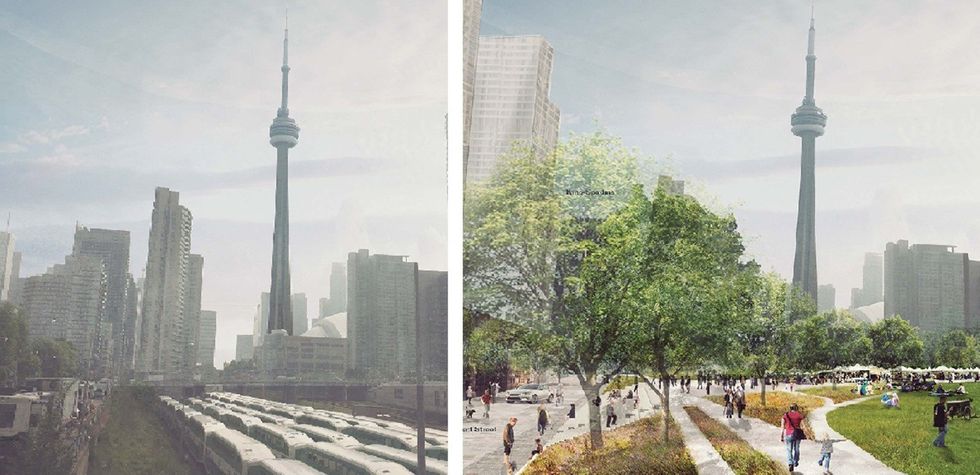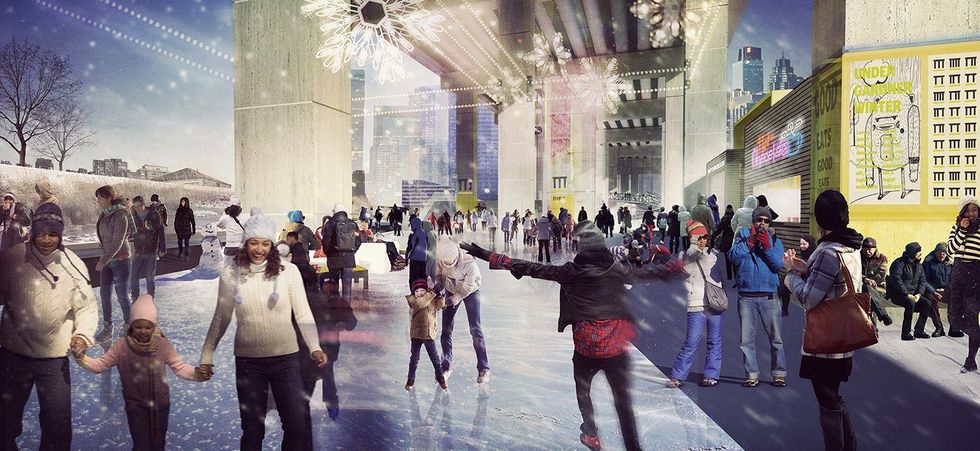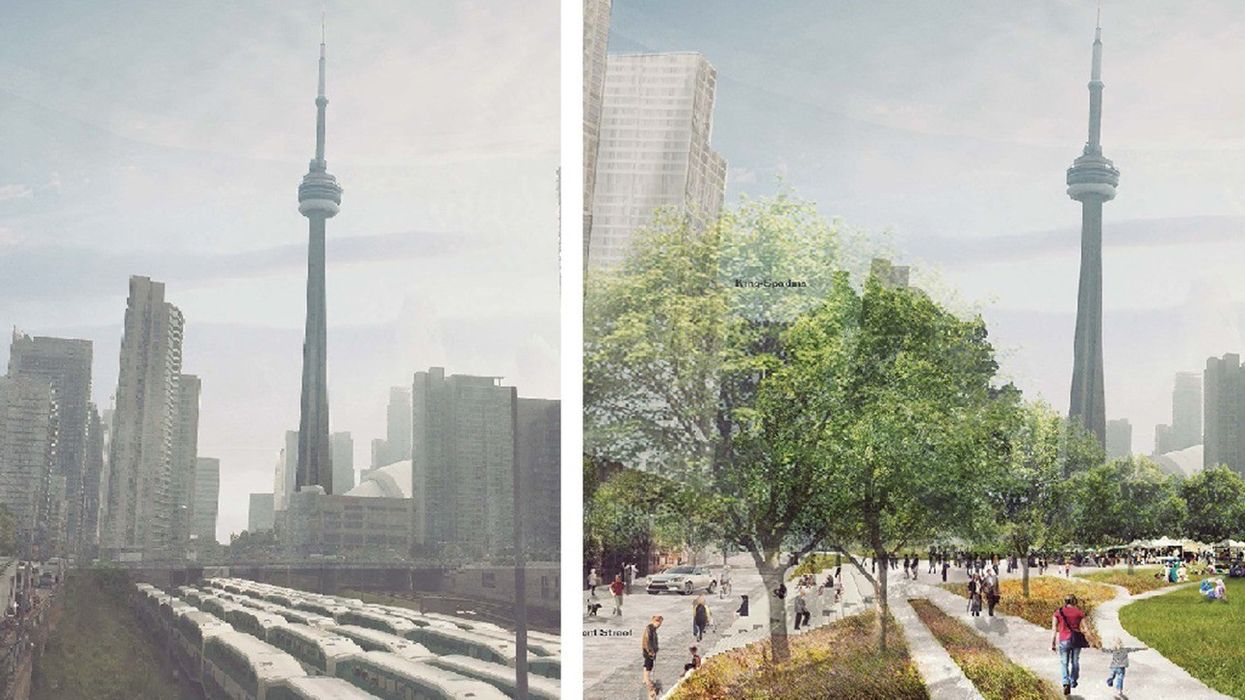If good intentions were enough, Toronto really might be the Greatest City in the World.
While expanded subways lines moved thousands across the GTA, new LRT vehicles above would hum along the streets full of happy commuters. Social housing would be indistinguishable from full market residences and condo towers would have rooftop playgrounds where laughing children amused themselves after school. Then there'd be Rail Deck Park, the 21-acre green space constructed above the railway tracks south of Front Street between Bathurst Street and Blue Jays Way.
Alas, good intentions are not enough. Transit is inadequate, as is subsidized housing. And, no surprise, in a city busy adding density at every corner, the lack of parks has suddenly become critical. Though Mayor John Tory has asked city staff for a parks and public realm plan by the end of the year, little has happened since Rail Deck Park was first announced last August.
More than $1 billion
Given that its location and cost is pegged at more than $1 billion, it was no surprise it prompted a display of the usual urban/suburban animosity. Councillors quickly started kvetching that the park is an expensive frill and glorified dog run for downtowners. If the city gets one, we want one too. That sort of thing.
Keeping in mind that the backlog of projects approved by city council now stands at more than $35 billion, no one should hold his or her breath. That's a shame. The park would be an enormous asset to a city that has lost control of growth. Such a large park would be hard, if not impossible, to put anywhere else in the city.
At the same time, however, city hall has failed to learn much about how to build green spaces that aren't green deserts.
The city's last great park, Corktown Common, was built in 2013 by Waterfront Toronto. Designed by Michael Van Valkenburgh of New York, the 18-acre facility takes advantage of the huge berm created to raise ground levels and stop flooding west of the Don River south of King Street. It deliberately engages visitors with a series of features ranging from pathways, ponds, pavilions and plants to a playground. It even includes a fireplace.
Before that there was Underpass Park, a much smaller venue, but one that attracts a younger crowd. Situated in the shadow of the elevated portions of Adelaide and Richmond streets, the innovative 2012 amenity is a place where basketball and skateboarding are actively encouraged. Another Waterfront Toronto project, it transformed land that sat empty and neglected for decades.
The agency can also claim responsibility for Sherbourne Common and the spectacular Sugar Beach, which is already established as a Toronto icon around the globe. Designed by Montreal landscape architect Claude Cormier, it took a small parcel of land across from the Redpath Sugar refinery at the foot of Jarvis Street on the edge of Lake Ontario and made it not just beautiful but sexy, something few would ever have thought possible before the "urban beach" opened in 2010.

None of these projects could have been done by the city. History tells us the municipal apparatus simply isn't capable of this kind of creativity and boldness, which brings us back to Rail Deck Park. Perhaps the best thing city hall could do would be to hand it over to Waterfront Toronto. It has funding issues, of course, and must endure the endless work of dealing with the three levels of government that appoint board members. But of all the city's myriad agencies, none can match Waterfront Toronto's record of excellence.
(Sadly, the mayor's designated waterfront representative is council's go-to philistine, Denzil Minnan-Wong. He has never been able to look beyond the printouts to see how the money has been spent. He is a dismal one-dimensional politician adrift in a 3D world.)
Kiss of death
Waterfront Toronto would require a change of the rules by which it operates. To start with, it needs borrowing and expropriation powers. That might enable it to implement Rail Deck Park before the end of the century. It's important to keep civic politicians and planners far away; their involvement in this project would be the kiss of death.
Let Waterfront Toronto handle the design and construction. Let it approach philanthropists and corporations for donations. Let it negotiate with developers who already have a claim on the site. The chief magistrate, chief planner and other municipal, provincial and federal dignitaries can cut ribbons and unveil plaques when necessary; but otherwise they must be kept at a safe distance.
Naturally, they would hate it if they couldn't take credit. But they know Rail Deck Park is more than they can handle. They confirmed that just last year when they wisely handed The Bentway, the wonderful facility now under construction underneath the Gardiner Expressway around Fort York, to Waterfront Toronto.

Even the mayor knew that putting city hall in control would mean endless delays and screw-ups. Don't forget that the cost of the innovative scheme was covered by an unprecedented $25-million gift from Toronto philanthropists Wilmot and Judy Matthews, who stipulated The Bentway must be completed by July 2017.
There's simply no way the city could meet so tight a deadline, not in 100 years, which is roughly how long it would need.
Toronto this, Toronto that
Finally, there's the issue of how the city thinks. One by one, at the Rail Deck unveiling, civic leaders trotted out the cliches about building Toronto's Central Park. On other occasions, it's Toronto's High Line, Toronto's this, Toronto's that. That sort of thinking is exactly what the city doesn't need.
But originality is not quality the municipality of Toronto values; indeed, it's terrified by the very idea. Waterfront Toronto, on the other hand, has created a culture of innovation that has brought the city global recognition and prepared it — or at least one part of it, the waterfront — for the future.
City hall may disapprove, but even Toronto will have to face its future at some point.





















